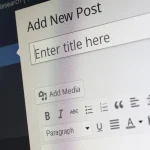Take control of your website’s design with custom page templates in WordPress. This guide walks you through the process, step-by-step, making it easy to create unique layouts for specific pages.
Code and Implementation: Create a Custom WordPress Page Template
Method: Using a Code Editor
1. Access Your Theme Files:
- Use an FTP client or your hosting provider’s file manager to access your website’s files.
- Navigate to the
wp-content/themesdirectory. - Locate the folder for your active theme.
2. Create a New Template File:
- Create a new PHP file within your theme’s folder.
- Name the file descriptively, following the convention
page-template-{your-template-name}.php. For example,page-template-full-width.phpfor a full-width template.
3. Add the Template Header:
- Open the newly created file in a code editor.
- At the beginning of the file, add the following code to declare the template:
<?php
/*
Template Name: {Your Template Name} (This will appear in the Page Attributes)
Description: A brief description of your template's purpose
*/- Replace
{Your Template Name}with a clear and descriptive name for your template (e.g., “Full Width Layout”). - Optionally, add a brief description in the
Descriptionfield.
4. Customize the Template Content:
- Include the core WordPress template tags and functions you need to structure your page’s layout. Here’s a basic example:
<?php get_header(); ?>
<div class="container">
<main role="main">
<?php while ( have_posts() ) : the_post(); ?>
<article id="post-<?php the_ID(); ?>" <?php post_class(); ?>>
<header class="entry-header">
<?php the_title( '<h1 class="entry-title">', '</h1>' ); ?>
</header>
<div class="entry-content">
<?php the_content(); ?>
</div>
</article>
<?php endwhile; ?>
</main>
<?php get_sidebar(); ?>
</div>
<?php get_footer(); ?>- Replace this basic structure with your desired layout, including elements like header, navigation, content area, sidebar (optional), and footer.
- Ensure you include necessary template parts using
get_header(),get_sidebar(), andget_footer().
5. Upload the Template File:
- Upload the modified theme folder (containing your new template file) back to your website using your FTP client or file manager.
Implementing the Template on a Page
1. Create a New Page:
- In your WordPress admin panel, navigate to Pages > Add New.
2. Assign the Template:
- In the Page Attributes section on the right-hand side, look for the “Template” dropdown menu.
- Select the custom template you created (e.g., “Full Width Layout”).
3. Publish the Page:
- Click “Publish” to make your page live with the custom layout.
Absolutely, let’s continue with some additional considerations and best practices for creating custom WordPress page templates:
Best Practices:
- Use a Child Theme: It’s highly recommended to create a child theme for your modifications. This ensures that your custom templates and code won’t be overwritten when your parent theme receives updates. Refer to the WordPress Codex for child theme creation.
- Template Hierarchy: Understand WordPress’s template hierarchy to strategically place your template files. This helps maintain a logical structure and avoid conflicts. You can find the hierarchy explained in the WordPress Codex.
- Code Readability: Write clean and well-commented code to make it easier for you or others to understand and maintain your templates in the future.
- Security: Always be cautious when modifying theme files. Use a trusted code editor and ensure you’re not introducing any security vulnerabilities.
Additional Considerations:
- Conditional Tags: Use conditional tags to control what content displays in your template based on specific conditions. For example, you might want to hide the sidebar on a specific page. Learn more about conditional tags here.
- Theme Styles: Make sure your custom template adheres to your theme’s styles or create custom styles for the template if needed.
- Testing: Thoroughly test your custom template on a staging environment before making it live on your website. This helps catch any potential issues before they affect your visitors.
Further Exploration:
If you’re looking to delve deeper into custom page templates, here are some helpful resources:
- WordPress Theme Handbook: The official WordPress documentation provides in-depth information on creating and customizing themes.
- Custom Page Templates in WordPress: Smashing Magazine offers a detailed guide with examples.
By following these guidelines and exploring additional resources, you’ll be well-equipped to create powerful and flexible custom page templates for your WordPress website.

